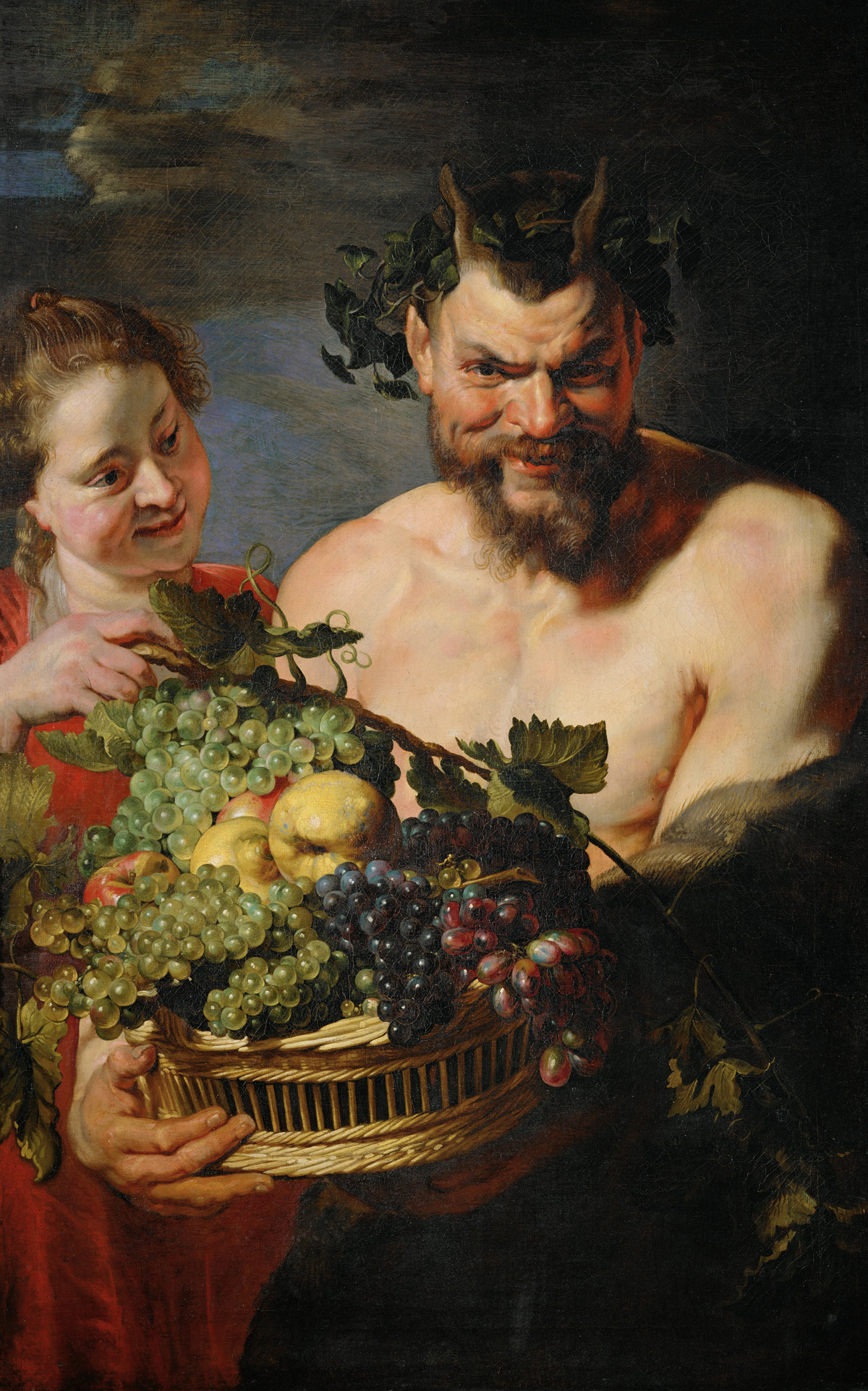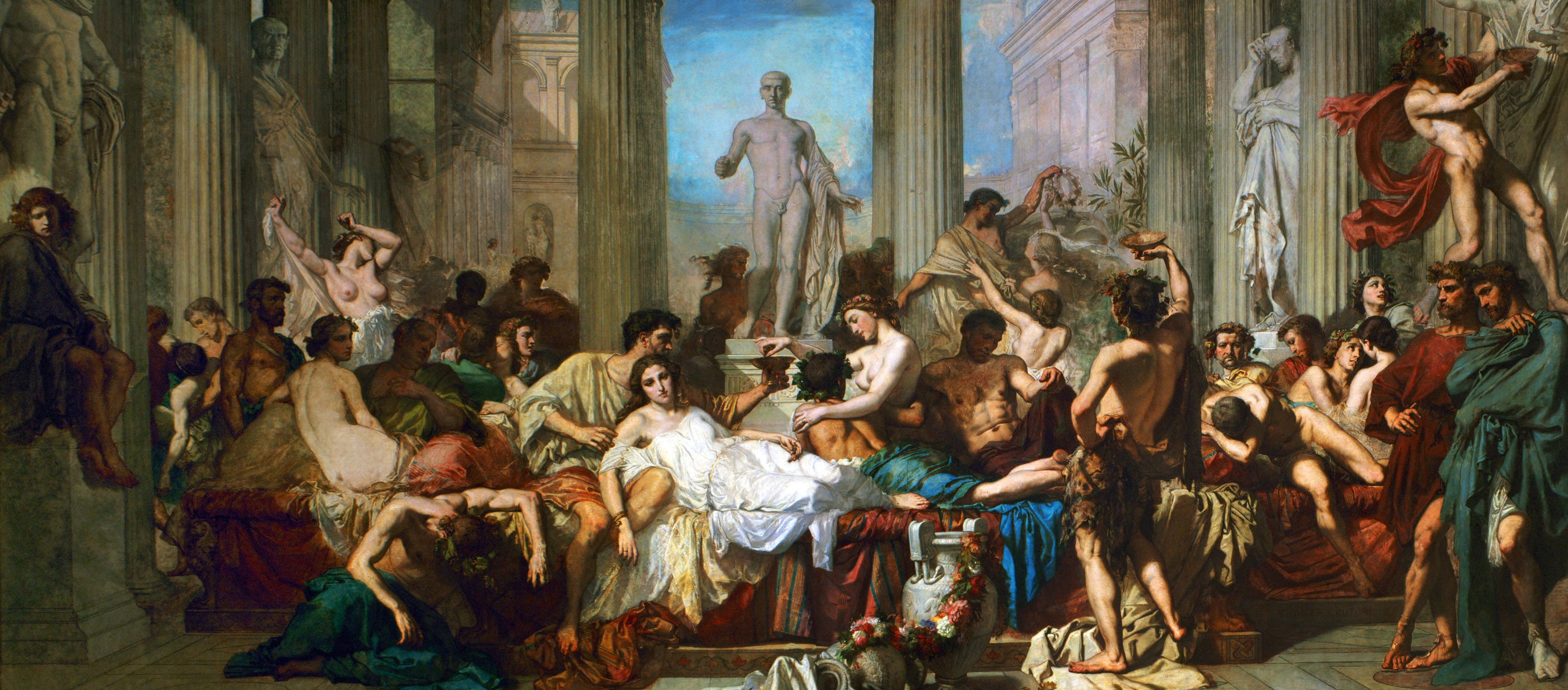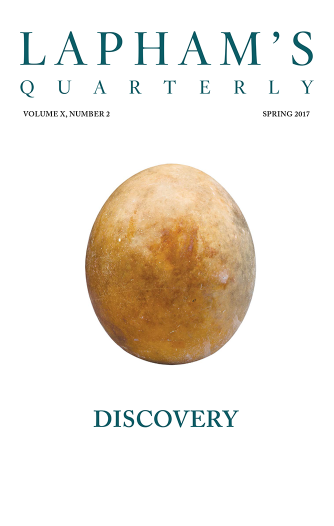One cannot think well, love well, sleep well, if one has not dined well.
—Virginia Woolf, 1929
Still Life, by Carstian Luyckx, c. 1640. Columbus Museum of Art.
Jesus answered, “It is written, ‘Man shall not live on bread alone, but on every word that comes from the mouth of God.’”
—The Gospel According to Matthew
It is a hard matter, my fellow citizens, to argue with the belly, since it has no ears.
—Cato the Elder
In both the periodical and tabloid press these days, the discussion tends to dwell on the bread alone—its scarcity or abundance, its price, provenance, authenticity, presentation, calorie count, social status, political agenda, and carbon footprint. The celebrity guest on camera with Rachael Ray or an Iron Chef, the missing ingredient in the recipes for five-star environmental collapse. Either way, sous vide or sans tout, the preoccupation with food is front-page news, and in line with the current set of talking points, this issue of Lapham’s Quarterly offers various proofs of the proposition that the belly has no ears.
No ears but many friends and admirers, who spread out on the following pages a cornucopia of concerns about which I knew little or nothing before setting the table of contents. My ignorance I attribute to a coming of age in the America of the late 1940s, its cows grazing on grass, the citizenry fed by farmers growing unpatented crops. Accustomed to the restrictions imposed on the country’s appetite by the Second World War’s ration books, and raised in a Protestant household that didn’t give much thought to fine dining (one ate to live, one didn’t live to eat), I acquired a laissez-faire attitude toward food that I learn from Michael Pollan resembles that of the Australian koala. The koala contents itself with the eating of eucalyptus leaves, choosing to ignore whatever else shows up in or around its tree. Similarly, the few primitive tastes met with before my tenth birthday—peanut butter and jelly, creamed chicken and rice, the Fig Newton—have remained securely in place for the last sixty-six years, faith-based and conservative, apt to be viewed with suspicion at trendsetting New York restaurants, in one of which last winter my asking about the chance of seeing a baked or mashed potato prompted the waiter to remove the menu from my hand, gently but firmly retrieving the pearl from a swine. The judgment was served à la haute bourgeoisie, with a sprig of disdain and a drizzle of disgust. Thirty years ago I would have been surprised, but thirty years ago trendsetting restaurants hadn’t yet become art galleries, obesity wasn’t a crime, and at the airports there weren’t any Homeland Security agents confiscating Coca-Cola.

Satyr and Maid with Fruit Basket, by Peter Paul Rubens, c. 1615. Residenzgalerie, Salzburg, Austria.
Times change, and with them what, where, and how people eat. In fifteenth-century London a man could be hanged for eating meat on Friday. An ancient Roman was expected to wear a wreath to a banquet. The potato in sixteenth-century Europe was believed to cause leprosy and syphilis. As of two years ago, 19 percent of America’s meals were being eaten in cars.
Prior to the twentieth century, the changes were relatively slow in coming. The text and illustration in this issue of the Quarterly reach across a span of four thousand years, during most of which time the global economy is agrarian. Man is the tenant of nature, food the measure of both his wealth and well-being. The earliest metal currencies (the shekel, the talent, the mina) represent weights and units of grain. Allowing for cultural difference and regional availability, the human family sits down to meals made of what it finds in the forest or grows in the field, the tables set from one generation to the next in accordance with the changing of the seasons and the benevolence of Ashnan or Ceres. To Achilles and Priam circa the twelfth century BC, Homer brings the meat “pierced…with spits,” the bread “in ample wicker baskets” with the same meaning and intent that Alexandre Dumas in nineteenth-century France imparts to the ripe fruit and the rare fish presented by the
Count of Monte Cristo to Monsieur Danglars.
It is the sharing of the spoils of the hunt and the harvest, a public as opposed to a private good, that sustains the existence of the earliest human societies, sows the seeds of moral value, social contract, distributive justice, and holy ground. The communal sacrifice entitles all present to a portion of the bullock or the goat and therefore to a presence in the assembly and a finger in the pie. Table manners are the teaching of both politics and philosophy, for Roman emperors as for the Renaissance scholar Desiderius Erasmus and the Confucian Chinese.
The contract between man and nature remains in force for as long as it is understood which one is the tenant and which one the landlord. Over the course of millennia men discover numerous ways of upgrading their lot—cooking with fire, domesticating animals and plants, bringing the tomato from Mexico to Spain, pepper from Sumatra to Salem, constructing the chopstick, the seine net, and the salad fork—but the world’s population stays more or less in balance with the world’s agriculture because the landlord is careful about matching supply and demand. The sum of the world’s economic enterprise is how much or how little anybody gets to eat, the number of those present above and below the salt accounting for the margin of difference between a bull and a bear market. For thousands of years the four horsemen of the apocalypse, war and famine prominent among them, attend to the culling of the human herd. Europe in the fourteenth century doesn’t produce enough food to serve the increasingly large crowd of expectant guests. The Black Death reduces by a third the number of mouths to feed.
The contract between landlord and tenant doesn’t come up for review until the seventeenth-century plantings of capitalist finance give rise to the Industrial Revolution. Man comes to imagine that he holds the deed to nature, persuaded that if soundly managed as a commercial real estate venture, the property can be made to recruit larger armies, gather more votes, yield more cash. Add to the mechanical staples (John Deere’s cast-steel plow, Cyrus McCormick’s reaper) the twentieth century’s flavorings of laboratory science (chemical pesticides, synthetic gene sequences), and food becomes an industrial product subsumed into the body of a corporation.
So at least is my understanding from what I’m told by the news media and learn from the labels at the supermarket, which isn’t much because the message wrapped in cellophane holds with the Pentagon’s policy of don’t ask, don’t tell. I rely instead on Aristotle, who draws the distinction between wealth as food and wealth as money by pointing out that the stomach, although earless, is open to instruction and subject to restraint. A man can only eat so much (1,500 pounds of food per year according to current estimates), but the craving for money is boundless—the purse, not the belly, is the void that is never filled. Paul Roberts fits Aristotle’s observation to the modern circumstance: “Food production may follow general economic principles of supply and demand; it may indeed create employment, earn trade revenues, and generate profits, sometimes considerable profits; but the underlying product—the thing we eat—has never quite conformed to the rigors of the modern industrial model.”
What is profitable is not necessarily edible; food apparently doesn’t get along well with assembly lines, farm-chemical runoff, antibiotics, and petroleum additives. Its quality deteriorates, as do the soils from which it springs and the health of the people to whom it is dished out. Roberts defines the problem as the imbalance between “what is demanded and what is actually supplied,” and the analogy that comes to mind is the story about the good King Midas, who wishes that everything he touches might turn to gold. Dionysus grants the request, and Midas discovers that he is unable to digest 24-karat cheese or 12-troy-ounce turbot.
Again, if I’m to believe what I read in the papers and infer from the taste of Taco Bell, the shift from an organic to an industrial food chain takes place in the second half of the twentieth century. The use of ammonium nitrate for fertilizer makes possible the production of immense quantities of hybrid corn processed into as many synthetic products (cranberry juice, whole-grain bread, toothpaste, aspirin) as a corporate marketing manager cares to germinate and name. Family farms give way to factory farms drawing their energies from fossil fuels in place of sunlight, the metamorphosis of two pounds of corn into four ounces of hamburger at the rate of one gallon of diesel fuel per acre; the chemical wastes that flow south with the Mississippi River from Iowa’s cornfields form a dead zone in the Gulf of Mexico equal in size to the state of New Jersey. The environmental damage is the cost of doing business, which is so abundantly successful that it allows for the presence of maybe as many as two billion people everywhere in the world who might not otherwise have been fed.
The changes move into position within the frame of my own lifetime, but I didn’t take much notice of their coming or going. In the vicinity of my childhood I have no recollection of such a thing as a supermarket; the greengrocer sold the fruit and the vegetables, the butcher supplied the pot roast and sometimes the steak. As a reporter for a San Francisco newspaper in the 1950s, I was often in the San Joaquin Valley to admire the apricots or praise the walnuts, but I don’t remember meeting any farmers who believed themselves resident in paradise.
On moving east to New York City in 1960, I formed the habit of eating in restaurants and with it the supposition that the pleasures of the table were those to be found in the company and the conversation rather than in whatever was the sun-dried specialty on the plate. My belated introduction to the notion of a higher food consciousness I owe to Julia Child. In the early 1960s, having served her apprenticeship at Le Cordon Bleu, she was conducting a cooking class on American public television, her program, The French Chef, so popular that the editors of The Saturday Evening Post sent me to take note of its being whipped up in a kitchen in Boston. The two days in her company—on set, at home, watching a taped sequence of her prior performances—were both a joy and a wonder to behold. A hearty and steadfast woman unburdened with affectation, Mrs. Child didn’t preach sermons—gastronomic, moral, or conceptual. So carefree was her approach to the materials in hand that when making a mess of a potato pancake, she didn’t lose her composure. “If this happens,” she said, “just scoop it back into the pan. Remember that you are alone in the kitchen, and nobody can see you.”
She took a simple and innocent delight in anything and everything she found pleasing (puff pastry or fish heads), her sense of enthusiastic discovery like that of
Duke Ellington’s finding “the best barbecued ribs west of Cleveland and the best shrimp Creole outside New Orleans.” One of her French Chef episodes opened on an artichoke boiling in a pot under a shroud of cheesecloth, Mrs. Child looming suddenly into the shot to lift the cheesecloth with heavy tweezers and an expression of cheerful surprise. “What’s cooking under this gossamer veil?” she said. “Why, here’s a great big bad artichoke, and some people are afraid of it.” She had a way of misplacing things, often the butter, sometimes the seasoning or the chopped carrots—on one memorable occasion, the turkey. Undismayed by random accident and secure in her belief that all’s well that ends well, she could point to chicken frying in a pan and say, reassuringly, “We just leave it there, letting it make simple little cooking noises.”
If from Mrs. Child I learned what little I know about gourmandizing, I was never troubled by the wish to live on a farm, there in the morning mist down by the Wabash to milk a cow, butcher a pig, or strangle a chicken. Brent Cunningham takes to task the notion of rural utopia dispensed from the pulpits of the food-reform movements and finds it suffused with a reduction of “bourgeois nostalgia,” an artisanal memory of sweet-water streams overflowing with trout, the countryside teeming with “poor but noble” people, “tough and hard-working…living healthier and fundamentally better lives than the rest of us.” The souvenir postcard is a misreading of American history. The story being told and retold in the old diaries and letters is not the one about a happy return to the well and the barn; it is the one about a desperate escape from the mud. Agriculture was never anything other than a hard row to hoe, and on reading the record I recognize myself as having been born into a uniquely privileged generation in an exceptionally fortunate country, never threatened, unlike most other people in most every other society that ever squatted on a riverbank or tented on the plains, by the fear, much less the fact, of starvation.
Together with every American housewife during the century denominated as America’s own, I welcomed the glut of packaged foods, was glad of the escape from having to cook, grateful for the kitchen conveniences, for the year-round strawberries, and the prompt home deliveries of saturated fat. In the company of travelers recently arrived from the Soviet Union and never before having seen a Stop & Shop, I shared their astonishment at the sight of what they perceived as a miracle.
I don’t bring the same sentiment into the restaurants that by the early 1990s had begun to come equipped not only with brushed and burnished steel but also with the atmospheres of devout observance that consecrate the exhibits of modern art. I never doubt the presence of grade-A epicures astonished by the revelation of A-list cuisine, the pleasure being taken in a well-dressed salad presumably akin to my own enjoyment of a well-turned phrase, but I suspect that as often as not it is the price of the thing that is precious, not the thing itself, and I notice that even when the food is mediocre, the sales pitch is invariably exquisite—succulent strings of heirloom adjectives and vintage nouns, wonderfully gratifying numbers ($465 for the tasting menu, $1,450 for the Napa Valley wine), literary ornament of a match with Tobias Smollett’s “virgin lymph, pure and crystalline as it gushes from the rock,” his “five-year-old mutton, fed on the fragrant herbage of the mountains,” his “rabbits panting from the warren.”

The Decadence of the Romans, by Thomas Couture, 1847. Musée d'Orsay, Paris.
Let the partaking of a truly expensive meal run to a five-course ritual of conspicuous consumption, and it becomes the proving of one’s salvation among the company of the elect. Who else but the rich can afford to pay so much for so small a shred of Kobe beef, can finance a holiday excursion to Le Cirque? The ancient agrarian societies dedicated the sacrificial bull or goat to Zeus or Jehovah; the modern capitalist society places the rhubarb gelée with gold leaf on the altar of Mammon. It was my failing to remember that I live in a consumer society, one more interested in the fine furnishing of its stomach than in the interior decoration of its mind, that encouraged the waiter in New York last winter to repossess the menu. Here I was being offered the chance to eat money—equivalent in the American scheme of things to the body and blood of Christ—and I was refusing the sacraments.
Fortunately for the self-esteem of America’s moneyed noblesse, the signs of Mammon’s good grace are certain to become increasingly conspicuous. Between March 2010 and March 2011, the average cost of food in U.S. cities rose to a forty-year high—iceberg lettuce up 48 percent, coffee 30 percent, bacon 24 percent, beef 21 percent, potatoes 14 percent. The worldwide cost of food meanwhile rose 37 percent, the cost of crude oil on the New York Stock Exchange 23 percent. All the available data indicates a steadily upward trend, the global market for food subject not only to crop failure and the loss of arable land but also to its uses as engine fuel.
The best-selling prophets of forthcoming dystopia name numerous probable causes, among them climate change, political upheaval, epidemic disease, and nuclear accident, but as the leading indicator of bad news, they seldom fail to mention the projected imbalance between the world’s food supply and a world population breeding at a rate that would have done credit to Squire Smollett’s rabbits—2.5 billion in 1950, 6 billion in 2000, 9.5 billion by 2050. Despite the twentieth century’s resort to mass murder and global war, the four horsemen of the apocalypse no longer can be counted upon to cull the herd, and the question that apparently needs to be addressed is whether the problem is animal, vegetable, or mineral. Does it lend itself to a solution in accord with the moral and metaphysical definitions of wealth as food, or in line with the capitalist understanding of food as money? Which is the void that stands the better chance of being filled, the belly or the purse?
Most vegetarians I ever saw looked enough like their food to be classed as cannibals.
—Finley Peter Dunne, 1900Submit the question to the law of biological necessity, and the belly, conscious of its limits, probably can be trusted to seek accommodation with nature.
Daniel Mason lists under the label of pica various purposeful ingestions of the inedible, among them the “calculated consumption of a Cessna 150” by the French performance artist, Monsieur Mangetout. Mason’s further study of geophagy (the eating of earth) leads him to the conclusion that men, as enlightened as the rat in the sophistication of their tastes and appetites, can learn to eat anything—bugs, chalk, limestone, millipedes, cinders, ants, cornstalks, charcoal, baby powder, and toilet paper. The opinion concurs with the wisdom and experience accumulated by Africa’s Yoruba people—“When the Muslim is not hungry he says,/We are forbidden to eat monkey./When he is hungry he eats a baboon.”
Refer the problem of overpopulation to the logic of the financial markets, and it’s not beyond the pale of sober economic thought to suppose that in addition to baboons, men can learn to eat their fellow primates, Catholic and Protestant as well as Muslim. The purse admits to no limit of its appetite, and as noted by Michael Pollan in The Omnivore’s Dilemma, human flesh is for the most part ambulant high-fructose corn syrup, a profitable commodity. Among the several correspondents in this issue of the Quarterly who remark on the practice of cannibalism, not even the rugby players obliged to eat their own teammates doubt its value as nourishment. The Greek physician Galen disapproves of “unscrupulous restaurateurs” who sell human flesh tagged as pork, but he doesn’t suggest that the meat, similar to that of a pig “in taste and smell,” is therefore indigestible. Bernal Díaz del Castillo attends a state dinner presented to the Aztec emperor Montezuma and reports the serving of “such a variety of different dishes, made of so many ingredients we could not tell whether a dish was of human flesh or anything else.” Díaz has been told that the Aztecs consume the flesh of young boys, but he has been assured that Montezuma, sensitive to European ethical and religious concerns, has forbidden its being served in the chafing dishes with the tame duck and wild boar.

The Slaughtered Ox, by Rembrandt van Rijn, 1655. Louvre Museum, Paris.
If no flaw is to be found in the product, then the difficulty is in the taste of a word, not a thing. Thus a familiar and straightforward problem for the people in charge of the marketing spin. Jonathan Swift’s
“A Modest Proposal” offers the early prototype of a rebranding campaign drawn up to provide relief from the poverty that in early eighteenth-century Ireland was littering the countryside with great crowds of “beggars of the female sex, followed by three, four, or six children all in rags,” children certain to grow up to become unsightly as well as unproductive members of society. Swift suggests that they be processed into a “most delicious, nourishing, and wholesome food,” liabilities transformed into assets, “whether stewed, roasted, baked, or boiled.”
Intended as satire in 1729, the proposal reads in 2011 like one of the “heart-healthy” promotions staged by the industrial food manufacturers, “connecting ideas to opportunities.” I can imagine Swift’s presentation finding favor with environmentalists alarmed by the threat to the world’s wildlife posed by the rising tide of humanity, also with the politicians frightened by the cost of the nation’s healthcare. The initiative would require only one revision—the use of a less emotionally compromised raw material. Children over the last three hundred years have acquired a high sentimental value, their approval ratings nearly equivalent to those reserved for baby polar bears. Obesity, however, is another story. It is seen, as was poverty in eighteenth-century Ireland, as a public disgrace, impolitic and immoral as well as unsightly. More people in the world now suffer from overnutrition (1.5 billion) than from malnutrition (900 million), and America has on hand a comfortingly large share of the global supply. The product enjoys the further advantage of qualifying for the labels “free-range” and “local.”




